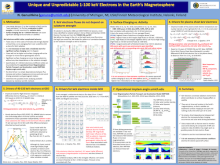Unique and Unpredictable 1-100 keV Electrons in the Earth’s Inner Magnetosphere
Natalia
Ganushkina
University of Michigan
Poster
Electrons with energies of 1-100 keV constitute a significant part of the inner magnetosphere population. These electrons are the seed population for the radiation belts, being accelerated to MeV energies by various processes in the Earth’s inner magnetosphere. Electrons within 10-50 keV energy range that surround spacecraft can cause surface charging. At present, the behavior of keV electrons is a puzzle in many ways. Their fluctuations occur on a time scale of minutes and their fluxes are local time-dependent. Increasing geomagnetic activity does not necessarily lead to the enhancements of their fluxes. Changes of 2-3 orders of magnitude in fluxes have been observed during smaller disturbances (e.g., isolated substorms) but without any clear dependence on the substorm strength. Accurate specification of 1-100 keV electrons at different orbits is of a key importance. Operational model in the inner magnetosphere, Inner Magnetosphere Particle Transport and Acceleration model (IMPTAM) provides the keV electron flux at all L-shells and at all satellite orbits (imptam.engin.umich.edu). It is driven by the real time solar wind and IMF parameters and by the real time Dst index but no matter how well it may predict, it is not a valid tool for effectively testing hypotheses about physical drivers.
We investigate the drivers of 1–100 keV electron flux in the inner Eath's magnetosphere employing statistical analysis of GOES 13/15/17/18, Van Allen Probes and THEMIS data, SWPSNN (Solar Wind Plasma Sheet Neural Network) model, and using autoregressive moving average transfer functions (ARMAX) multiple regression models which remove the confounding effect of diurnal cyclicity and allow assessment of each parameter independently.
We investigate the drivers of 1–100 keV electron flux in the inner Eath's magnetosphere employing statistical analysis of GOES 13/15/17/18, Van Allen Probes and THEMIS data, SWPSNN (Solar Wind Plasma Sheet Neural Network) model, and using autoregressive moving average transfer functions (ARMAX) multiple regression models which remove the confounding effect of diurnal cyclicity and allow assessment of each parameter independently.

Poster PDF
Poster category
Geospace/Magnetosphere Research and Applications
Poster session day
Poster location
8
Meeting homepage